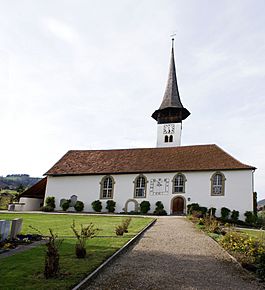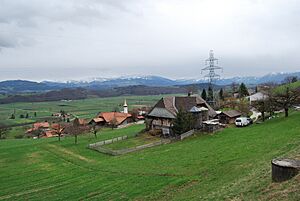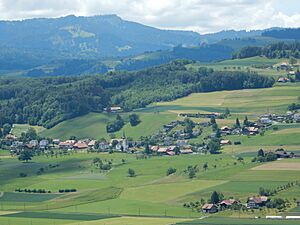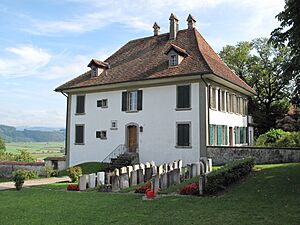Kirchenthurnen facts for kids
Quick facts for kids
Kirchenthurnen
|
||
|---|---|---|
 |
||
|
||
| Country | Switzerland | |
| Canton | Bern | |
| District | Bern-Mittelland | |
| Area | ||
| • Total | 1.3 km2 (0.5 sq mi) | |
| Elevation | 612 m (2,008 ft) | |
| Population
(Dec 2012)
|
||
| • Total | 272 | |
| • Density | 209/km2 (542/sq mi) | |
| Postal code |
3128
|
|
| Surrounded by | Gelterfingen, Mühledorf, Mühlethurnen, Riggisberg, Rümligen | |
Kirchenthurnen was once a small town, or municipality, located in the Bern-Mittelland area of the Bern canton in Switzerland. It was a part of the larger canton of Bern. On January 1, 2020, Kirchenthurnen joined with two other towns, Lohnstorf and Mühlethurnen. Together, they formed a new, larger municipality called Thurnen.
Contents
History of Kirchenthurnen
Kirchenthurnen was first mentioned in official records in 1228. Back then, it was simply known as Tornes. Until 1860, its name was Thurnen. The name was changed to Kirchenthurnen to avoid confusion. There was another nearby town called Mühlethurnen, and the similar names caused problems.
Early Settlements and Village Ownership
The oldest signs of people living here are graves from the Hallstatt culture period. These ancient graves were found in a gravel pit called Ried. By the 1300s, a powerful family from Bern, the von Blankenburgs, owned the village.
The village church was first mentioned in 1228. In 1343, the Blankenburg family gave the village, its church, and the surrounding lands to Interlaken Monastery. This monastery was a religious community.
The Reformation and Bernese Rule
In 1528, the city of Bern adopted a new Christian faith called the Protestant Reformation. This meant they took control of Interlaken Monastery. Because of this, Kirchenthurnen also came under the rule of Bern. It became an important center for the area, known as the bailiwick of Thurnen. A bailiwick was like a local administrative district. Later, in the 1700s, this center moved to Mühlethurnen.
Population Changes Over Time
In the 1800s, the number of people living in Kirchenthurnen started to grow. However, after 1880, the population went down for a while. In the 1960s, it began to grow again. This happened because the city of Bern was expanding. Many people who worked in Bern moved to smaller, more distant communities like Kirchenthurnen. By the year 2000, about two-thirds of the people who worked in Kirchenthurnen actually traveled to jobs outside the town.
Geography and Landscape
Kirchenthurnen covers an area of about 1.3 square kilometers (0.5 square miles). Most of this land is used for farming. About 77.6% of the area is agricultural land. Forests cover about 10.4% of the town's land. The rest, about 12.0%, is settled with buildings and roads. A very small part, 0.8%, is made up of rivers or lakes.
Most of the settled area, 8.0%, has houses and other buildings. Roads and other transportation areas make up 3.2%. All the forested land is covered with thick forests. For farming, 46.4% of the land is used for growing crops. Another 30.4% is used for pastures where animals graze. All the water in Kirchenthurnen is flowing water, like streams or small rivers.
Kirchenthurnen is located in the Gürbetal (Gürbe valley). It sits on the eastern side of a slope called the Längenberg. The church area, or parish, of Kirchenthurnen is quite large. It includes several nearby towns. These are Burgistein, Kaufdorf, Lohnstorf, Mühlethurnen, and Rümligen.
In 2010, Kirchenthurnen became part of a new administrative area. It joined the newly created Verwaltungskreis Bern-Mittelland. This change helped organize the local government better.
Coat of Arms
The official symbol, or coat of arms, for Kirchenthurnen is simple. It shows a silver tower with battlements (the notched top of a castle wall) on a red background.
Population and People
As of December 2012, Kirchenthurnen had a population of 272 people. A small part of the population, about 2.9%, were people from other countries. Between 2010 and 2012, the population changed only a little. More people were born than died, but a few more people moved away than moved in.
Most people in Kirchenthurnen speak German. In 2000, about 97.3% of the population spoke German as their main language. A small number, about 1.0%, spoke French.
In 2008, the population was made up of 45.1% males and 54.9% females. Most residents were Swiss citizens. About 25.0% of the people living in Kirchenthurnen in 2000 were also born there. Many others, 56.2%, were born in the same canton of Bern. About 12.3% were born elsewhere in Switzerland, and 5.1% were born outside Switzerland.
In 2012, young people (ages 0-19) made up 16.9% of the population. Adults (ages 20-64) were the largest group at 59.9%. Seniors (over 64 years old) made up 23.2%.
In 2000, there were 110 single people in the town. There were 142 married people, 22 widows or widowers, and 18 divorced individuals.
In 2010, there were 39 homes where only one person lived. There were also 3 homes with five or more people. Most apartments, 91.3%, were lived in all the time. Only a few were empty or used only part of the year.
The chart below shows how the population of Kirchenthurnen has changed over many years:

Economy and Jobs
In 2011, Kirchenthurnen had a low unemployment rate of 2.15%. This means most people who wanted to work had jobs. That year, 56 people were employed in the town.
Types of Jobs
Jobs are often grouped into three main types:
- Primary sector: These jobs involve getting raw materials from nature. This includes farming, fishing, and mining. In Kirchenthurnen, 23 people worked in this sector, mostly in agriculture. There were 8 businesses in this area.
- Secondary sector: These jobs involve making things from raw materials. This includes manufacturing and construction. In Kirchenthurnen, 19 people worked in this sector. There was 1 business.
- Tertiary sector: These jobs involve providing services to people. This includes teaching, healthcare, and retail. In Kirchenthurnen, 14 people worked in this sector, with 7 businesses.
In 2008, there were 43 full-time equivalent jobs. This means if you add up all the hours worked, it was like 43 people working full-time. Most of these jobs were in agriculture and construction. A few were in manufacturing and education.
Commuting and Travel
In 2000, 29 workers traveled into Kirchenthurnen for their jobs. However, 126 workers traveled away from Kirchenthurnen to work in other places. This means many people living in Kirchenthurnen commute to jobs elsewhere. About 57.4% of the workers in Kirchenthurnen also lived there. To get to work, 15.8% used public transportation. A larger number, 55.2%, used a private car.
Taxes and Financial Help
In 2011, the average tax rate for a married person with two children in Kirchenthurnen was 12.5%. For an unmarried person, it was 18.3%. These rates were a bit lower than the average for the whole canton of Bern.
In 2011, a small part of the population, 2.9%, received financial help from the government. This assistance helps people who need extra support.
Religion
According to the 2000 census, most people in Kirchenthurnen belonged to the Swiss Reformed Church. About 88.7% of the population were members. A smaller group, 4.1%, were Roman Catholic.
There were also a few people who belonged to other Christian churches. Some people, about 3.77%, did not belong to any church. They might have been agnostic (not sure if God exists) or atheist (do not believe in God). A very small number of people did not answer the question about their religion.
Education
In Kirchenthurnen, many adults have completed good levels of education. About 63.1% of the population finished non-mandatory upper secondary education. This is like high school or vocational training after basic schooling. Also, 12.7% went on to higher education, such as a university or a specialized college.
School System in Bern
The school system in the Canton of Bern works like this:
- Kindergarten: One year of non-obligatory kindergarten. This means children don't have to go, but many do.
- Primary School: Six years of primary school.
- Lower Secondary School: Three years of obligatory lower secondary school. Students are grouped based on their abilities and what they are good at.
- After Secondary: After lower secondary, students can choose to continue their schooling or start an apprenticeship. An apprenticeship is a way to learn a trade or skill while working.
During the 2011-2012 school year, 39 students from Kirchenthurnen were attending classes. There was one kindergarten class in the town with 15 students. Kirchenthurnen did not have its own primary school classes. Instead, 18 students went to primary school in a nearby town. There was one lower secondary class with 6 students.
In 2000, 29 students attended school in Kirchenthurnen. Of these, 22 lived and went to school in the town. The other 7 students came from other towns. In the same year, 10 residents of Kirchenthurnen went to schools outside the town.
See also
 In Spanish: Kirchenthurnen para niños
In Spanish: Kirchenthurnen para niños
- Thurnen, Bern







